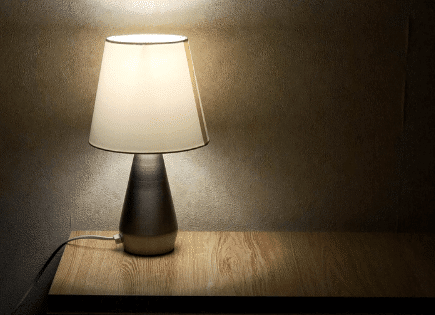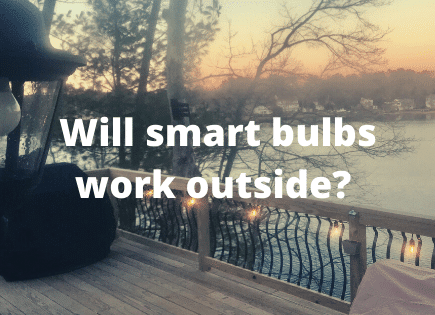
Z Wave vs Zigbee: An In-depth Comparison (BIG News in 2022!)
I came across the terms “Z Wave” and “Zigbee” a lot the first day I started looking into smart home products. After a little research of my own, I was still unsure of exactly what the differences between them were. And, more importantly, whether or not I should even care.
Since you’re here, I’m willing to bet you’re experiencing something similar.
Z Wave vs. Zigbee – which is better?
It’s true that Z Wave has a better track record of compatibility between products and never interferes with your Wi-Fi network. However, Zigbee is faster, has a greater range of signal, boasts an open protocol standard, and owns a significantly larger market share of the smart home product space.
Oh, and Zigbee was recently included in the smart home open-source standard collaboration alongside Apple, Google, and Amazon. Z Wave, notably, was left out.
While there are many similarities between the Z Wave and Zigbee protocols, there are also some key and important differences to understand. Several of which are new as of this year.
After several hours of research and over a year of personal experience, I present to you the official Z Wave vs. Zigbee manifesto for 2022. My goal for this post is to present you with all the information and direction you need to start building your smart home comfortably.
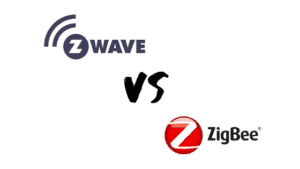
Take a look at the Z Wave vs Zigbee chart below for a high-level comparison of the protocols and then read on for a more in-depth analysis.
| Category | Z Wave | Zigbee | Winner |
|---|---|---|---|
| Network config | Wireless mesh network | Wireless mesh network | Push |
| Open or closed protocol standard | Closed (Update: Open as of Dec 2019) | Open | Zigbee |
| Included in 2020 smart home open source standard alliance | No | Yes | Zigbee |
| Compatible with other products | Yes | Most of the time | Z Wave |
| Security | High (AES128 encryption) | High (AES128 encryption) | Push |
| Power usage | Low | Low | Push |
| Frequency | 908.42 MHz | 2.4 GHz | Z Wave |
| Wi-Fi interference | No | Possibly, but likely negligible | Z Wave |
| Max Data Rate | 100 Kbps | 250 Kbps | Zigbee |
| Range of network | Line of sight: Up to 100+ meters (328 ft) Indoors: Up to 9 meters (30 ft) | Line of sight: Up to 300+ meters (984+ ft) Indoors: Between 75-100 meters (246-328 ft) | Zigbee |
| Total devices supported on one network | 232 devices | 65,000 devices | Zigbee |
| Number of products on the market | 3,200 | 3,500 | Zigbee |
| Number of certified products sold | 100 million | 300 million | Zigbee |
| Hub required | Yes | Yes | Push |
| Winner! | 3 categories | 7 categories | Zigbee |
What are Z Wave and Zigbee anyways?
Z Wave and Zigbee are protocols that allow your smart home products to communicate with one another. You can think of them as languages: Z Wave speaks French while Zigbee speaks Spanish.
More technically they are “wireless radio frequency communication” protocols used primarily for home automation.
Both create something called a mesh network using low-energy radio waves to communicate from device to device. Mesh networks allow devices to link together by branching, or hopping off each other. This allows the signal and network to spread further and more reliably.
So, by definition, the more devices you have speaking the same language within the mesh network, the easier it becomes for them to communicate with each other.
Why do Z Wave and Zigbee protocols exist?
With the advent of the IoT (Internet of Things), and more specifically consumer IoT, companies began to build and market their own smart home products.
These products needed a way to communicate with one another. Protocols like Z Wave and Zigbee were invented to handle this communication.
But as more and more companies got into the space, it became clear that there was a big issue for companies and their developers. There was no standard in place for all of these products to speak with one another.
In the absence of this standard, companies have had to make a decision about which protocol to use in their products. Some companies have even gone as far as to build two versions of the same product, one using one protocol and the other using a different protocol. Hopefully appealing to more consumers by ensuring that their products were compatible.

For the most part, the everyday consumer has been pretty well shielded from this dilemma. That’s because smart hubs like Samsung SmartThings, Hubitat Elevation, Wink Hub 2, and others have been able to help mask the issue.
Smart hubs integrate with the major languages, or protocols, in the market and help to translate them. This allows products with different protocols to work together. That’s why you can have Z Wave and Zigbee products under the same roof, “working together.”
Why don’t companies just use Wi-Fi as the smart home standard?
It’s a fair question.
And plenty of smart products today do leverage Wi-Fi. There are however several notable downsides.
For starters, many of your traditional home products today already use Wi-Fi. By adding more you run the risk of congesting your home network and slowing things down.
And, while Wi-Fi has a high data rate, it also consumes a lot of power. This makes Wi-Fi less than ideal for wireless smart home products that require batteries. Not a great experience when you have to swap out your product’s batteries every three weeks.
And finally, maybe worst of all, if your Wi-Fi goes down, so does your smart home network.
Ok, so Z Wave or Zigbee?
Now that you have a basic understanding of these technologies and why they exist, let’s dig deeper into the pros and cons of each.
We’ll start by addressing the elephant in the room. The common smart home standard collaboration between Apple, Google, Amazon, and Zigbee, was announced in December 2019.
If you haven’t heard about this collaboration, Apple released a nice explanation here.
If you don’t feel like reading their whole post, here’s the gist:
The idea behind the collaboration is to create a new connectivity standard to increase compatibility among smart home products (as of mid-2021, they are referring to this standard as “Matter“).
This way developers can focus on making their products compatible with a single standard, instead of making the same product compatible with multiple protocols.
Notice Z Wave isn’t included in this collab.
Always the bridesmaid.
Protocol Standard and Compatibility
Since its inception, Z Wave was a proprietary standard, which means the protocol was owned by a single company (Silicon Labs, as of early 2018).

Early on this worked in the favor of Z Wave – since a single entity owned the protocol it could strictly enforce compliance with its rules, and it did.
Z Wave certification was mandatory for all companies wanting to make Z Wave products. This usually meant that Z Wave products worked more reliably with other Z Wave products. They were always frontwards and backward, compatible, and well-tested.
However, the closed nature of this protocol was often criticized by consumers and companies alike because it meant that only Silicon Labs could create and sell Z-Wave chips that go into “Z Wave” smart products.
When only one company can make something that means no competition. And no competition typically means higher prices for consumers (or, at a minimum, total price control).
If Z Wave were to “win” as the smart home protocol standard, Silicon Labs would stand to make a ton of money.
Contrast this with Zigbee, which has always been an open standard.
As an open standard, many different companies have had the opportunity to build Zigbee chips. Coincidentally enough, Silicon Labs is one of these companies. They make both Z Wave and Zigbee chips. The major difference is that historically, only they could make Z Wave chips whereas Zigbee chips can be made by anyone.
Since more companies can make Zigbee chips, they are slightly cheaper than Z Wave chips due to the added competition.
As a result, there has also been a slightly higher adoption by companies, and ultimately consumers, of the Zigbee standard.
But being an “open” standard has also come at a cost.
Without a single, centralized manufacturer and owner of Zigbee chips/standards, there have been challenges ensuring all Zigbee devices work with all other Zigbee devices (new and old).
And while there is a Zigbee certification, it is voluntary. You can’t force companies to do anything when something is open. Even when it is in their customer’s best interest, and therefore their company’s best interest.
Z Wave makes a big change, but is it too late?
After Z Wave learned about the smart home standard collaboration, which they were left out of, they decided to make a big change. As of December 2019, Silicon Labs is allowing other companies to make Z Wave chips, effectively turning Z Wave into an open standard overnight.
They also decided to spin off their Z Wave certification program into an independent organization, outside of Silicon Labs. An important step in ensuring the Z Wave protocol remains open.
The goals here are obvious:
1) Allow more companies to build Z Wave chips, theoretically increasing adoption of the Z Wave standard and
2) Get an invite to the conversations that have already started between Apple, Google, Amazon, and Zigbee
Whether or not this move was made too late is yet to be seen. But I think this is definitely a step in the right direction for Z Wave and its future.
Winner

When it comes to Z Wave vs. Zigbee and their protocol standards and compatibility, I have to go with Zigbee. While there have been some challenges with compatibility in the past, I believe Zigbee’s long history of an open standard and their inclusion in the recent smart home standard collaboration between Apple, Google, and Amazon, gives them a leg up in the years to come.
Security
In regards to Z Wave vs. Zigbee security, both protocols use AES 128-bit encryption. And they use it at the same level that major banks use to protect your financial information.
AES stands for Advanced Encryption System. It’s an encryption algorithm used in IT applications to secure all sorts of sensitive data.
AES was chosen back in 2001 as an official government security standard, but over time it’s also become the go-to encryption standard for the private sector. And for good reason.
AES encryption is largely considered to be unbreakable and is one of the most secure encryption methods used today.
Winner
Push. Both Z Wave and Zigbee have a high level of security built into their protocols.
Power Consumption
Both Z Wave and Zigbee are extremely energy efficient, and they have to be since many of their products rely solely on battery power.
As a result, batteries often don’t need to be changed for a year or more.
Zigbee, for example, uses as little as 0.05 Watt-seconds per data transmission. That’s tiny!
They also allow for sleeping end devices. This means the products go into sleep mode when not being used. That requires significantly less energy than fully powered devices.
That said, both Z Wave and Zigbee require a smart hub so you will need to keep that hub plugged in at all times in order to keep the network up and running.
Winner
Push. Both Z Wave and Zigbee use consume very little power.
Frequency
Remember, Z Wave and Zigbee are wireless radio frequency communication protocols. This means they use radio waves to send signals and communicate. The frequency at which these waves travel is different for each protocol.
Z Wave radio waves travel at 908.42 MHz. Z Wave operates in the below-1GHz band. Which means it will never interfere with Wi-Fi and other wireless technologies that operate in the 2.4 GHz band (Bluetooth, Zigbee, etc.)
Zigbee radio waves on the other hand travel at 2.4 GHz. This is the same frequency at which Wi-Fi travels and has the potential to cause some issues.
However, third-party testing has determined that Zigbee has little-to-no impact on Wi-Fi. Zigbee sends small and quick data packets, and its products have access to 16 separate, 5MHz channels within the 2.4GHz band. Several of these channels don’t interfere with Wi-Fi at all.
Ultimately WiFi does affect Zigbee. But only in terms of latency – the Zigbee message eventually gets through, but with a 20 to 30 ms delay. Negligible to you and me.
Winner

The Z Wave vs Zigbee frequency competition is close, but I have to go with Z Wave. It is an exceptionally small leg up on Zigbee. But since Z Wave operates on a different frequency than Wi-Fi altogether, it cannot interfere with it. That said, any interference caused by Zigbee is likely unnoticeable and inconsequential.
Range
These days smart products have to be able to reach all areas of your home and your property. Whether you have a motion sensor out in the backyard to trigger some outdoor lighting or a garage door opener, you need your products to reach these locations.
On average Z Wave devices have an indoor range of about 30 ft and Zigbee devices have an indoor range of about 246-328 ft.
The exact range of numbers varies from home to home based on the building materials used and the layout.
The range of each protocol can be extended by adding more products. In doing so, the mesh network becomes stronger. The signal jumps from device to device until it reaches the device being used.
Winner

For the Z Wave vs. Zigbee range competition, Zigbee wins. That said, each device added to your home strengthens the network and improves the range, so it is something that can be overcome.
Speed
The connection speed of data is measured in kilobits per second (Kbps). The higher the number of Kbps, the faster the speed.
Smart products could be sending something as large as video recordings (smart cameras) or as small as temperature readings (smart sensors).
Depending on the size of the data being sent, speed may or may not be a factor.
Nevertheless, Zigbee is faster by a good margin, with a speed of 250 Kbps. Compared to Z Wave’s speed of 100 Kbps.
To give you some reference, dial-up internet had a speed of 56 Kbps. That was about 20 years ago. So at about double that speed or even five times that speed, Z Wave and Zigbee, respectively, are relatively slow.
Speed is usually unimportant with many smart products as the amount of data sent is small.
Winner

For the Z Wave vs Zigbee speed competition, Zigbee wins with a speed of 150 Kbps faster than Z Wave.
Number of supported devices
This one is pretty self-explanatory so I’ll keep it short.
Z Wave can support up to 232 devices and Zigbee can support 65,000+ devices.
For your everyday homeowner, both protocols will work just fine. If you need more than 232 smart devices in your home, I want a tour! You’re living in a mansion.
For the rest of us, Z Wave and/or Zigbee should suffice.
Now, if you own a hospital, mall, or some other large commercial space, and you’re considering smart protocols, I’d stick with Zigbee to make sure you’re not capped at any point.
Winner

For the Z Wave vs Zigbee number of supported devices competition, Zigbee wins by a landslide. But ultimately, if you’re a homeowner, both Z Wave and ZigBee should support your needs.
One metric that’s useful when comparing products or protocols is the amount of market share one has vs the other.
In the case of Z Wave vs Zigbee, Zigbee has about 300 more certified, interoperable products (3,500) on the market today than Z Wave (3,200).
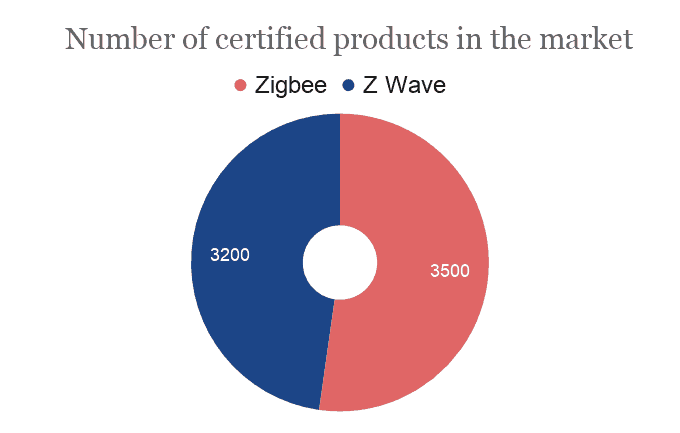
Looking a bit deeper at the number of products sold, Zigbee has over 300 million certified products operating throughout the world today. Compared to 100 million Z Wave products worldwide.
Numbers don’t lie. Zigbee has taken a bigger piece of the smart home product pie.
A genuine concern a lot of smart home consumers have is product obsolescence. Because there isn’t a true standard, the fear is that their smart product will become worthless overnight, running a protocol that is no longer supported.
Winner

Zigbee simply does more to alleviate those concerns. Zigbee has a long history of an open standard, a strong presence in the marketplace, and inclusion in the Google, Apple, and Amazon collaboration. At this point, I just have a little more faith that they will be around for the next 10 or 20 years.
Hub Requirement
It should be no secret that Z Wave and Zigbee products require a hub to operate.
There are a number of smart hubs that support each protocol. Many support both simultaneously.
Some of the more popular smart hubs are:
- Samsung SmartThings
- Hubitat Elevation
- Wink Hub 2
If you buy a hub that works with both Z Wave and Zigbee, you’ll able to use them both side-by-side in your home. I personally do this today and it never causes a problem.
I own Zigbee products and Z Wave products, which all connect to my Samsung SmartThings hub.
The hub acts as the brains of the operations, and since the hub can speak multiple languages, it’s able to take a message from one product and communicate it to another, ensuring that everything works together.
For this reason, you don’t need to worry too much about which protocol you choose.
The real benefit of choosing the same protocol is that the more products you have running that protocol, the stronger your mesh network becomes and the more reliable and stronger the signal.
Winner
Push. Both Z Wave and Zigbee require a hub.
Conclusion: Z Wave vs Zigbee
Historically, Z Wave vs Zigbee has been an extremely close “competition,” often leaning in favor of Z Wave, due to its superior interoperability and ease of use.
While the competition is still somewhat close, Zigbee comes out on top by a small margin in 2022 and the foreseeable future.
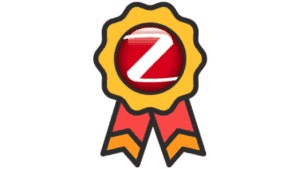
It is hard to ignore the market share that Zigbee has won. And their inclusion in the 2020 Smart Home Open-Source Standard Collaboration. And, more notably, Z Wave’s exclusion from this collab.
Personally, I don’t think either protocol is in danger of going away any time soon. If you make me choose which one I think will be here for the next 20 years, I’m going with Zigbee.
If you’re building a smart home today with 40+ smart products, I would make a conscious effort up front to try and stick with a single protocol, either Z Wave or Zigbee. This will ensure that your mesh network is strong and reliable.
If you’re just an average smart home user starting today, I would begin by choosing a smart hub integrated with Z Wave and Zigbee. That way you don’t need to worry about it.
That’s what I do and it works great. I haven’t had any issues for over a year with this approach. Thanks, Samsung SmartThings Hub.

If you’re interested in buying a SmartThings Hub, you can use this link from Amazon.
Ultimately, whichever protocol you decide to use is up to you! Thanks for reading!

